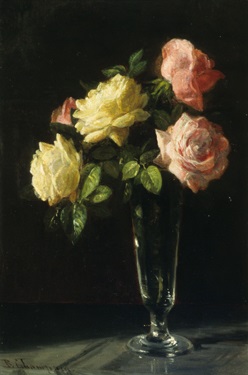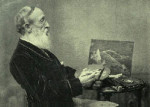
Benjamin Champney
American, 1817-1909
Pink and White Roses in a Glass Vase, 1864
oIl on canvas
SBMA, Gift of Charles C. and Elma Ralphs Shoemaker
1994.34.4

Undated photo of Champney
"I love art, no matter in what shape or guise it may be. One rose painted in a truthful loving way claims my admiration, and I can love almost an infinite variety of subjects well presented from the simple, well studied rose up to the grandest historical canvas."
-Benjamin Champney
RESEARCH PAPER
The museum’s beautiful Pink and White Roses in a Glass Vase by Benjamin Champney is a still life that has been and carefully painted by someone who clearly loved flowers. A clear glass vase holds pink and white roses and sits upon a dark gray, perhaps slate, table or counter. It is easy to miss, but the vase sits on a glass tray. The wall behind the vase is black with dark maroon shading toward the bottom of the wall. The eye immediately focuses on the roses. We are drawn by its beauty and by the serenity and calm that the arrangement conveys. These roses would be called "old fashioned" by today’s rosarians. No one has torn off the older, curled bottom petals to "tidy them up" as we often do now. The artist has skillfully created what appears to be a haphazard or casual arrangement. One sees a diagonal line as well as an inverted triangle. The leaves are ribbed and pointed at the ends that are very realistic. Some texture is obvious from the brush strokes, but much of the texture is implied. Light filters in at the bottom left of the painting, casting a shadow across the table from the vase. We can see through the vase one stem with two thorns. Small dabs of white paint make light bounce off the glass vase. The colors are soft and exquisite. The white roses have some off white and pale beige in the lower petals, indicating that these are older roses and will probably soon fall off. The pale pink roses have various shades of pink and some dark pink shading and white to add to the depth of the blossom.
The fifth of seven children, Benjamin Crackbone Champney was born to Benjamin and Rebecca Brooks Champney on November 20, 1817 in New Ipswich, New Hampshire. Because his father died when he was only ten years old, he was forced to leave home and live with his maternal aunt in Lebanon, New Hampshire. He was sent by stagecoach on the eighty-mile trip, which took two days. He attended the local school that lasted only twelve weeks during the winter. He worked for his uncle in a cotton mill for the rest of year. The same aunt adopted one of his younger sisters. He wrote that among his happiest hours in his boyhood were those spent with this sister. They were great friends and both loved to draw. Had she lived to adulthood, he thought she would have been a successful artist.
In his early adolescence, he spent his leisure time drawing without the benefit of a teacher. He felt he made little progress. At age fourteen he returned to his mother’s home and attended Appleton Academy. He expected to get an appointment to West Point through the influence of Congressman Franklin Pierce. But, he writes, "Probably like many other Congressmen, he made too many promises and I was left out in the cold to my great disappointment." At sixteen, he moved to Boston and was a shoe merchant’s clerk. Fortunately he then became an apprentice for a lithographer where he got his first experience in the world of art. In the summer of 1838, he made his first trip to the White Mountains and their great beauty astounded him. At that time the White Mountains were still considered wilderness. This summer excursion had a profound influence on his career as a painter.
As a young man, there were few opportunities for him to study painting. Washington Allston, a well know painter at that time, had an exhibition of forty-five paintings in Boston. As frequently as he could, Champney would follow Allston when he talked about his paintings in the gallery. Champney and his good friend, Robert Cooke, were invited to bring their sketches to Allston’s home. He encouraged the young men and told them that they should study in Paris.
In May 1841, Champney and Cooke traveled to Paris. Champney attended drawing and painting classes in the morning and often copied paintings at the Louvre in the afternoons. He shipped some of his originals as well as copies from the Louvre home for sale. He became aware of the work of Georges Jeanin whom he considered to be the greatest contemporary painter of flowers. In 1844, three of Champney’s paintings were accepted for exhibition at the Salon in Paris, but in 1846 the Salon rejected two other paintings. (One of those rejected, Claudian Aqueduct, is now in the Yale University Art Gallery.) Champney was often in financial distress as were many other young American artists. They formed what they called the OMC- the out of money club. Despite the scarcity of money, he was able to travel to Germany, Switzerland, and Italy to paint. He became an apprentice to Jean Vanderlyn (1775-1852), an American painter living in Paris. After waiting for years, Vanderlyn had finally been commissioned by Congress to paint The Landing of Columbus for the rotunda in Washington. Champney was happy to receive five francs a day and believed he got valuable lessons from this well-known painter.
In 1846 he returned to Boston and exhibited four paintings at the Boston Athenaeum the following year. In May 1847, he sailed for Paris and survived a shipwreck off the coast of Nova Scotia. He attempted another sailing and arrived safely in Paris. He also survived the uprising and overthrow of Louis Phillippe in 1848. His description of the revolutionary events in his autobiography is fascinating. Paris seemed doomed. He writes of the soldiers who could not fire upon the crowds as ordered, because they were friends and brothers. He describes the destruction of most of the contents of the Palace. Fine paintings and portraits were ruined with bayonet thrusts. At the American legation, he climbed a ladder and wrote in chalk on the building that it housed the representative from America.
A major goal of his return to Paris was to paint a Panorama of the Rhine. He had three assistants. It is believed to have been twelve hundred feet long, consisting of four three hundred foot rolls. He shipped it to Boston and began his business of promoting the Panorama. Henry Wadsworth Longfellow offered many helpful suggestions for the public booklet. Champney received praise and good press reviews. Fortunately the public became more aware of his ability as a landscape artist. The project, however, was a financial disappointment and the Panorama was eventually destroyed in a fire in 1858 while in winter storage.
By the mid nineteenth century, landscape painting was a major theme in American art. In the summers of 1850 and 1851, Champney and some artist friends returned to the White Mountains to paint the scenery. These paintings attracted other young artists to the area. He is considered the founder and the dean of the White Mountain School of Painters who came to North Conway, New Hampshire in the summer to paint in the last half of the nineteenth century. In the summer of 1853, he married Mary Caroline Brooks (1829-1876), known as Carrie. They were able to buy a home in North Conway with a large carpenter shop that he made into an art studio. There were spectacular views from the house and other views only a short walk away. Benjamin and Carrie loved being there in the off-season, but to receive commissions and improve his business, they returned to their home in Woburn for the winter. In 1854, he was a founder of the Boston Art Club. This provided a means for local artists to share their ideas and to display their works. Besides exhibiting at the Boston Athenaeum, he exhibited at the Pennsylvania Academy of Fine Arts in 1863. He also exhibited at New York City’s National Academy of Design. During the Civil War (which he referred to as the war of the rebellion), fewer tourists came in New Hampshire and those who did had less money to spend on paintings. In 1864, he painted the still life that the Museum owns. When he remembered this time, he recalled:
"… It is a difficult problem to solve the lessons that nature gives us in flowers, with their great variety of glowing tints and delicate forms. I would not care to see the forms delineated with the exactness of the Dutch flower painters where cold details overpower the general effect of brilliant color and softness, and mar the breadth of the composition, and where the skill in imitating a drop of dew is one of the chief things to admire.
"Neither would I go to the other extreme, and in trying to give breadth lose the strong individual characteristics of each flower, or slur over the forms to make the work more decorative. The trouble is to find the juste milieu between slouchiness and too much exactness of form, -- to make a suggestive picture rather than a positively realistic one."
In June 1865, the Champneys went to Europe. He was able to revisit favorite places from his student days and observe the new trends in European art. He especially admired Monet’s work, but not the works of all Impressionists. He observed:
"Dashes and daubs of paint do not necessarily make pictures…All artists should not run after the same craze, even if it is new and strange. Impression is just as much a conventional thing as any of the older manners and by and by it will have had its day and be superseded perhaps by something still more grotesque, if that be possible…"
The 1870s brought increasing popularity and exhibitions of his paintings. Sadly, in October 1876, his wife died of an illness of the brain at the age of forty seven. In 1879, he married Margaret Stevenson.
Champney became known for his painting of flowers that looked so natural. Most of his still life paintings were created between 1885 and 1907. Flowers were painted most frequently. As he aged, he led a quieter life and by 1900 he had been forgotten by most of the public. He published a very delightful autobiography, Sixty Years of Art and Artist, at the urging of his friends. He painted every day until his death of influenza at the age of ninety. His last painting, it is believed, was of flowers.
Prepared for the Santa Barbara Museum of Art Docent Council by Betsy L. Kain, March 27, 2003
Benjamin Champney, Sixty Years Memories of Art and Artists, pages 161-162.
Ibid, page 7.
Ibid, page 154.
Ibid, page 135.
